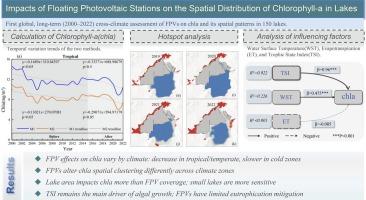浮动光伏电站对湖泊叶绿素-a空间分布的影响
IF 6
2区 工程技术
Q2 ENERGY & FUELS
引用次数: 0
摘要
为了评估FPV站在全球范围内对湖泊水体chla浓度的影响,我们在全球三个气候带选择了150个FPV站。利用2000年至2022年的5458个Landsat图像场景,我们模拟了fpv安装前后的chla浓度。采用热点分析方法比较了FPV装置对湖水chla浓度空间聚类的影响。结果表明:(1)在热带和温带地区,浮游生物所在的湖水中chla浓度呈下降趋势;在寒冷地区,FPVs湖水chla浓度下降速度有所减缓。(2) fpv改变了chla的空间聚类。在热带地区,低值聚类增加,高值聚类减少。在寒冷地区,高值和低值集聚都有所增加。在温带地区,高值聚类和低值聚类均减少。(3)植被覆盖度不是影响chla浓度的决定因素。事实上,湖泊表面积越大,chla浓度通常越低。(4)与TSI对chla浓度的显著影响相比,FPVs对chla浓度的影响相对较弱。虽然通径分析显示TSI对chla具有显著且强烈的正向因果关系,但基于遥感影像和空间聚类分析的结果主要反映的是相关性,而不是严格的因果关系。本文章由计算机程序翻译,如有差异,请以英文原文为准。

Impacts of floating photovoltaic stations on the spatial distribution of chlorophyll-a in lakes
To assess the impact of FPV stations on chla concentrations in lake water bodies on a global scale, we selected 150 FPV installations across three climatic zones worldwide. Using a total of 5,458 scenes of Landsat imagery from 2000 to 2022, we simulated chla concentrations before and after the installation of FPVs. Hotspot analysis was then applied to compare the effects of FPV installations on the spatial clustering of chla concentrations in lake water. The results revealed that: (1) In tropical and temperate zones, the concentration of chla in the lake water where FPVs are located has decreased; in cold zones, the decline rate of chla concentration in the lake water of FPVs has slowed down.(2) FPVs alter the spatial clustering of chla. In tropical zones, low-value clustering increases while high-value clustering decreases. In cold zones, both high-value and low-value clustering increase. In temperate zones, both high-value and low-value clustering decrease. (3) The coverage of FPVs is not the determinant factor influencing chla concentrations. In fact, larger lake surface areas generally corresponded to lower chla concentrations.(4) Compared with the significant influence of TSI on chla concentration, the impact of FPVs on chla concentration is relatively weak. Although path analysis reveals that the TSI has a significant and strong positive causal effect on chla, our results based on remote sensing imagery and spatial clustering analysis primarily reflect correlations rather than strict causality.
求助全文
通过发布文献求助,成功后即可免费获取论文全文。
去求助
来源期刊

Solar Energy
工程技术-能源与燃料
CiteScore
13.90
自引率
9.00%
发文量
0
审稿时长
47 days
期刊介绍:
Solar Energy welcomes manuscripts presenting information not previously published in journals on any aspect of solar energy research, development, application, measurement or policy. The term "solar energy" in this context includes the indirect uses such as wind energy and biomass
 求助内容:
求助内容: 应助结果提醒方式:
应助结果提醒方式:


